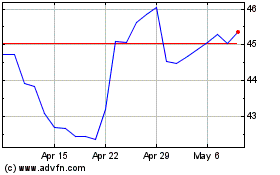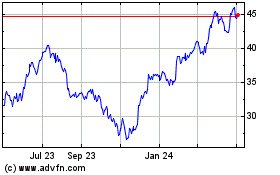By Ben Foldy and Mike Colias
General Motors Co. is looking to build a second battery factory
in the U.S. with joint-venture partner LG Chem Ltd., the latest
move in the Detroit auto maker's efforts to expand its investment
in electric vehicles.
A GM spokesman confirmed to The Wall Street Journal that the
companies are exploring building a second battery-cell plant and
said a decision could come in the first half of this year.
GM and LG are close to completing a decision to locate the plant
in Tennessee, said people familiar with the matter. A final
selection hasn't yet been made, the people said.
Already, the two companies are building a $2.3 billion battery
plant in northeast Ohio that is expected to open next year and
eventually supply enough batteries to power hundreds of thousands
of vehicles annually. The new plant is likely to be a similar-size
investment, some of the people said.
GM, the nation's largest auto maker by sales, has set ambitious
targets for converting its global lineup to electric vehicles,
revealing its aim earlier this year to phase out gas-engine models
from its showrooms by 2035.
The rush by GM and other global car companies to sell more
plug-in models has stoked concerns among auto executives and
analysts over future battery shortages and has led some auto
manufacturers to get in the business of making their own battery
cells, often in joint ventures with big battery makers.
LG Chem is in discussions with GM to add battery production,
said Seungse Chang, the company's senior vice president of
corporate strategy at its battery-making subsidiary, in a
statement. The company also plans additional expansions of its U.S.
battery-making operations to support other auto makers, he
said.
The Biden administration has made transitioning from gas-powered
to electric vehicles a cornerstone of its domestic policy agenda,
aiming to use the technology both to fight climate change and
create new jobs to help cushion the possible loss of some in
fossil-fuel industries.
The White House last week ordered a review of the U.S. battery
supply chain, aiming to lessen dependence on countries like China,
which currently dominates the market for batteries and their
materials.
GM is investing $27 billion in electric and driverless cars
through mid-decade, among the industry's most aggressive bets.
Unlike some rivals, GM is using in-house battery technology,
branded Ultium, which company executives say will lower battery
costs by nearly 40% on new plug-in vehicles that begin to roll out
over the next year compared with those it sells today.
It is also supplying the technology to Honda Motor Co. to
develop new electric models, and GM is looking for more such deals,
GM Chief Executive Mary Barra said last week.
Ms. Barra is counting on 30 new battery-powered GM models
globally by 2025--two-thirds of which are slated for North
America--to deliver profit growth. Currently, the company sells
only one electric model in the U.S., the Chevrolet Bolt, along with
a few in China, and generates all its profit from gasoline- and
diesel-powered vehicles.
Today, most battery manufacturing occurs in Asia and Europe, and
the battery production that is in the U.S. is largely controlled by
Tesla Inc., according to research firm Benchmark Mineral
Intelligence. For example, the recently launched Ford Mustang
Mach-E relies on batteries made in Poland.
But as auto makers prepare to sell more electric cars in the
U.S., they also want to reduce the sizable costs of shipping heavy
batteries across oceans, executives say.
Some car companies, such as GM and Volkswagen AG, have moved to
vertically integrate, joining partners like LG and Northvolt AB to
invest in their own battery-cell factories and lock in supplies.
Tesla, meanwhile, operates a battery plant in Nevada with Panasonic
Corp.
Ms. Barra hinted recently that GM may expand its battery-making
capacity beyond the Ohio factory but hasn't discussed specific
plans.
"We are already seeing the benefits of having our own cell
manufacturer, " she said during a virtual investor conference last
week. "It's allowing us to go much deeper into the supply base to
secure what we need."
The company already has begun retooling its North American
factory network to build more plug-in vehicles. It is spending
roughly $6 billion to convert assembly plants in Detroit, Spring
Hill, Tenn., and Ingersoll, Ontario, to build plug-in cars.
The new U.S. battery plant would be a third for South Korean
battery maker LG Chem. The company is also embroiled in a
trade-secret dispute with rival SK Innovation Co., which it claims
stole LG's trade secrets through a targeted campaign of poaching
employees. SKI has denied the allegations.
Last month, the U.S. International Trade Commission affirmed an
earlier finding in LG's favor that SKI destroyed evidence. The
decision threatens to derail a large battery factory project SKI is
constructing in Georgia. Both companies met last month with the
Biden administration, according to people familiar with the
meetings, and LG's representatives believe the company would be
able to increase U.S. production to cover any shortfalls caused by
sanctions on SKI.
Write to Ben Foldy at Ben.Foldy@wsj.com and Mike Colias at
Mike.Colias@wsj.com
(END) Dow Jones Newswires
March 04, 2021 05:44 ET (10:44 GMT)
Copyright (c) 2021 Dow Jones & Company, Inc.
General Motors (NYSE:GM)
Historical Stock Chart
From Mar 2024 to Apr 2024

General Motors (NYSE:GM)
Historical Stock Chart
From Apr 2023 to Apr 2024
